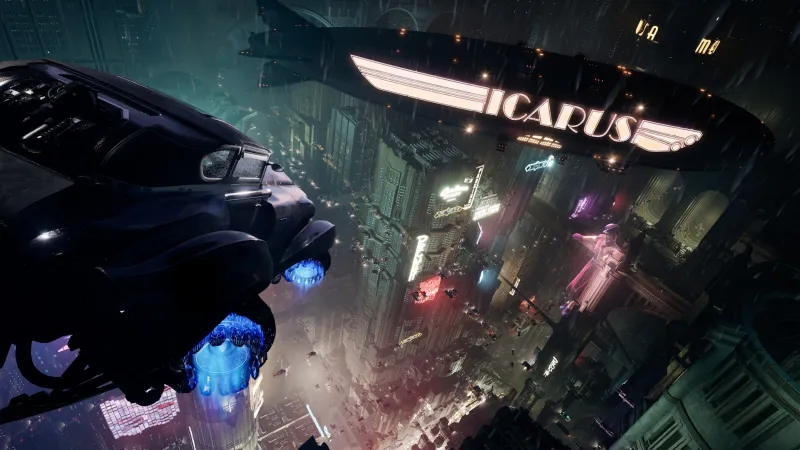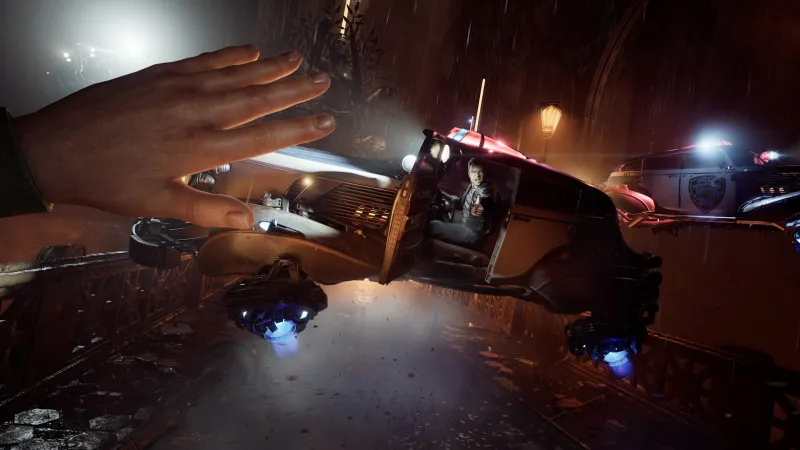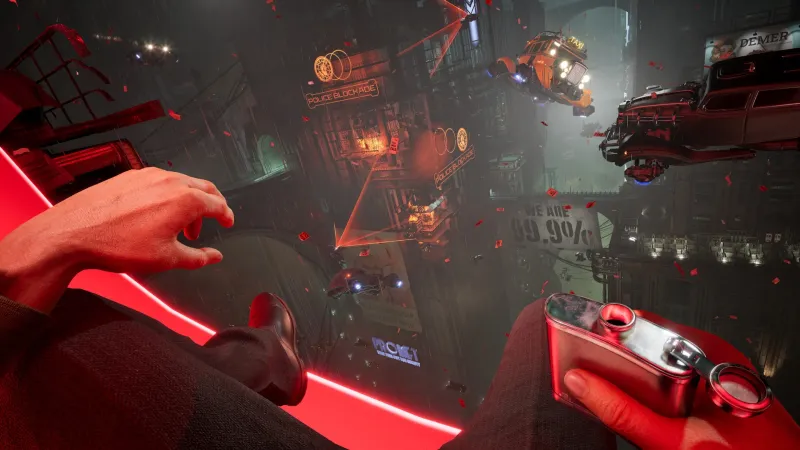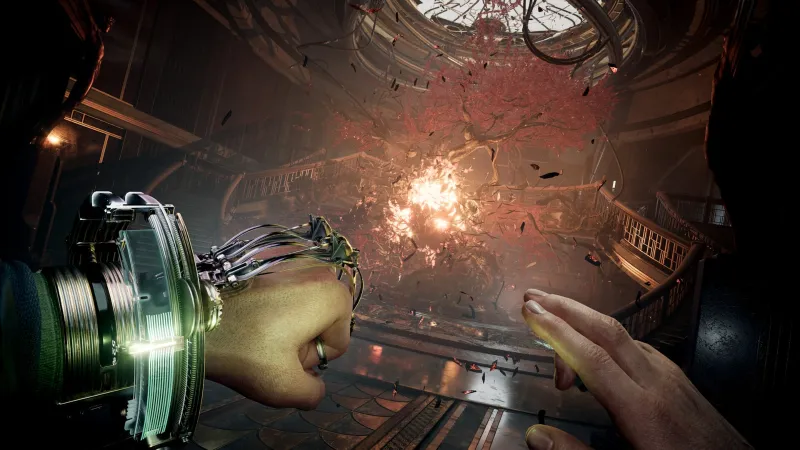Reviewed on:
PC
Platform:
PlayStation 5, Xbox Series X/S, PC
Publisher:
Plaion
Developer:
Critical Hit Games
Release:
Rating:
Mature
Nobody Wants to Die’s world terrifies me. Set only a few hundred years in the future, it paints a dystopian society where humanity has unlocked the secret to immortality, but instead of eternal bliss, it paved the way for the government to have full legal control of our bodies. The world is as fascinating as it is upsetting, and a high-profile murder becomes the catalyst for a gripping (though not always actively engaging) mystery within it.
Since Blade Runner‘s release in 1982, renditions of a cyberpunk metropolis have been plentiful and familiar. Nobody Wants to Die’s bleak depiction of 2329 New York City stands out as one of my favorites due to its effective fusion of Art Deco. The game looks as if technology skyrocketed in the 1930s while retaining that era’s aesthetic; vintage cars soar across the polluted airways of the concrete jungle, and futuristic gadgets have a Tomorrowland-esque design. In addition to a strong art direction, the graphical fidelity is top-notch with beautiful lighting illuminating the densely detailed cityscape and interiors. Nobody Wants to Die is a gorgeous game, and a clever introductory reveal of its world ranks among my favorite moments of the year.
The visuals invited me in, and the world-building kept me. After developing the ability to transfer human consciousness to different bodies, humanity has essentially solved death. People routinely live for centuries by switching to new, more desirable bodies, engendering a terrible system where citizens must pay a subscription fee to keep their original shell after coming of age. Failing to do so results in government seizure, where your consciousness is forcibly extracted and stored in a memory bank while your body goes up for sale. The less affluent 99% may have to settle for occupying aging or medically compromised bodies. If you can’t afford a new body, your conscious mind could be trapped in a bank for decades or longer. From Orwellian government promotions of a healthy lifestyle to prevent citizens from becoming damaged goods to reintroduction parties where people familiarize loved ones with their new bodies, developer Critical Hit Games has crafted an intriguing culture around this concept. Every lore detail, whether through new paper headlines or radio broadcasts, added substance to the presentation’s sizzle.
The politics surrounding immortality means morally dubious politicians and celebrities can maintain their status and control for obscenely long periods of time. In a world where true death is a rarity, the mysterious murder of one elite figure rattles the cages. Protagonist James Karra, a 120-year-old loose-cannon detective, is tasked with finding the culprit in an off-the-books case. The first-person adventure sees James visiting crime scenes and using a small set of high-tech forensic tools to collect clues and reverse engineer sequences of events. Whether using a handheld X-ray to trace a bullet’s trajectory, shining a UV lamp on hidden blood trails, or, most often, using a time-manipulating gauntlet to rewind and scrub through a chaotic moment, I enjoy assembling the pieces of smaller puzzles to form the big picture.
Detective work isn’t difficult, relying less on deductive reasoning and more on thoroughly poking around and uncovering every intractable element available. I don’t mind this more guided approach, as finding clues can lead to insightful and entertaining conversations with James’ partner Sara, who provides remote tech support in his ear. The two share some fun, sarcasm-heavy banter, such as an optional exchange where Sara asks James to describe the smell of chocolate (which no longer exists). The performances, especially Sara’s, are strong enough to make their relationship feel genuine and endearing. Their back-and-forth also adds welcomed levity, though James’ hard-boiled noir detective act means he often spews verbose monologues with metaphors that sometimes make limited sense.
Connecting clues in a flow chart between investigations is a game of determining which piece of evidence answers the question at hand. In reality, you can cheese this by just slotting in every clue until the right one fits, but I always wanted to deduce the answer properly. That said, Nobody Wants to Die is ultimately a narrative-focused adventure that uses detective-inspired gameplay as a vehicle to tell its story. You can’t really get anything wrong, and so if you’re hoping for true agency in how you approach solving this conspiracy, you’ll be disappointed.




You can, however, steer the plot in different directions thanks to the choice-driven dialogue and significant decision-making moments, adding stakes to conversations. Some choices have timers and can be as simple as deciding whether or not to drink on the job; an inebriated James may open an additional dialogue option. Bigger decisions, like deciding whether or not to kill a suspect or to destroy or preserve incriminating evidence, alter the plot more significantly. While that provides a good incentive to replay the roughly five-hour adventure, you’ll have to trek through the entire game again since it lacks a chapter selection, which is unfortunate.
Nobody Wants to Die does an admirable job juggling three main story threads: the aforementioned murder, James’ struggle to remember and come to terms with a traumatic event surrounding his wife’s death, and a heartbreaking tale involving Sara I won’t spoil. These plot points are disjointed at times; I’d make a big breakthrough in the murder case I wanted to follow up on immediately, only for the story to shift focus on James’ problems for a period. A mysterious villain at the center of it all is menacing at first but winds up feeling too obscure by the end. Perhaps it’s a result of my choices, but I’m still not entirely sure what the antagonist’s true goal was or even who they were. Though the main threat falls a bit flat, the story regularly gripped me and sprinkled a few effective twists and revelations that kept me guessing until the conclusion.
Nobody Wants to Die delivers a few hours of largely engaging storytelling, easy yet well-presented puzzle-solving, and jaw-dropping sights. It has an ideal length, as it wraps up just when the long investigation segments begin feeling repetitive since your toolset never changes. While I didn’t get to wear my detective hat as tightly as I wanted, I enjoyed my tour through this cautionary vision of the future.
